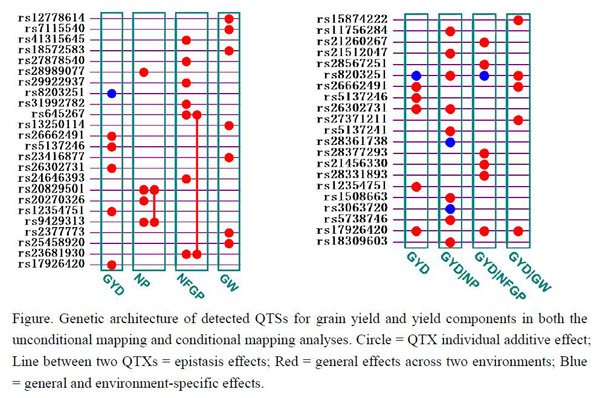






Genetic dissection of yield traits in super hybrid rice Xieyou9308 using both unconditional and conditional genome-wide association mapping
April 24th, 2017
Rice is a fundamentally important staple crop, and improving rice yields has remained a major goal in world agriculture. Super hybrid rice shows great advantages in grain yield and biomass in comparison with conventional rice varieties. Since its inception in China in 1996, super rice breeding program has achieved tremendous increases in rice yields. However, the genetic basis underlying this high yield potential remains largely unclear. In order to fuel the further successes of super rice breeding programs, continued efforts to dissect the genetic basis of economically-important traits will be necessary.
Recently, researchers from China National Rice Research Institute (CNRRI), Chinese Academy of Agricultural Sciences, Institute of Crop Science and Institute of Bioinformatics, College of Agriculture and Biotechnology, Zhejiang University, Sir Run Run Shaw Hospital, School of Medicine, Zhejiang University, Arkansas Children’s Hospital Research Institute, School of Medicine, University of Arkansas for Medical Sciences successfully uncovered the genetic mechanism of Xieyou 9308’s high yield potential. Xieyou 9308 is one of the most famous super hybrid rice varieties with a grain yield as high as 12.23 t/ha. A recombinant inbred line (RIL) population derived from cross of XieqingzaoB and Zhonghui9308 was re-sequenced and investigated on the grain yield (GYD) and its three component traits, number of panicles per plant (NP), number of filled grains per panicle (NFGP), and grain weight (GW). Unconditional and conditional genome-wide association analysis, based on a linear mixed model with epistasis and gene environment interaction effects, were conducted, using ~0.7 million identified SNPs. There were six, four, seven, and seven QTSs identified for GYD, NP, NFGP, and GW, respectively, with accumulated explanatory heritability varying from 43.06% to 48.36%; additive by environment interactions were detected for GYD, some minor epistases were detected for NP and NFGP. Further, conditional genetic mapping analysis for GYD given its three components revealed several novel QTSs associated with yield than that were suppressed in our unconditional mapping analysis.
This work was supported in part by the project of the National Sci-Tech Support Plan (2011BAD35B02), the Major Sci-Tech Programs of Zhejiang Province (2012C12901-3), the National Natural Science Foundation grants 31101203, 31521064 and 31671570, the National Science Foundation grant DMS1462990, and the Bill and Melinda Gates Foundation Project. The research finding has been published in Scientific Reports online on April 11, 2017 (DOI: 10.1038/s41598-017-00938-7). More details are available on the links bellow: http://www.nature.com/articles/s41598-017-00938-7


· Study Reveals How the Clock Component OsLUX Regulates Rice Heading
· Scientists Further Unravelled the Underlying Mechanism of Heading Date Control in Rice
· Improving the efficiency of prime editing in rice
· A New Infection Mechanism of Ustilaginoidea virens is Revealed
· Scientists Further Reveal the Infection Mechanism of Ustilaginoidea virens
CNRRI Today
Copyright © 2014- China National Rice Research Institute